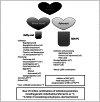Improving platelet transfusion safety: biomedical and technical considerations
- PMID: 26674828
- PMCID: PMC4781777
- DOI: 10.2450/2015.0042-15
Improving platelet transfusion safety: biomedical and technical considerations
Abstract
Platelet concentrates account for near 10% of all labile blood components but are responsible for more than 25% of the reported adverse events. Besides factors related to patients themselves, who may be particularly at risk of side effects because of their underlying illness, there are aspects of platelet collection and storage that predispose to adverse events. Platelets for transfusion are strongly activated by collection through disposal equipment, which can stress the cells, and by preservation at 22 °C with rotation or rocking, which likewise leads to platelet activation, perhaps more so than storage at 4 °C. Lastly, platelets constitutively possess a very large number of bioactive components that may elicit pro-inflammatory reactions when infused into a patient. This review aims to describe approaches that may be crucial to minimising side effects while optimising safety and quality. We suggest that platelet transfusion is complex, in part because of the complexity of the "material" itself: platelets are highly versatile cells and the transfusion process adds a myriad of variables that present many challenges for preserving basal platelet function and preventing dysfunctional activation of the platelets. The review also presents information showing--after years of exhaustive haemovigilance--that whole blood buffy coat pooled platelet components are extremely safe compared to the gold standard (i.e. apheresis platelet components), both in terms of acquired infections and of immunological/inflammatory hazards.
Figures


Eligibility, temporary or permanent deferral;
Type of donation (WB or apheresis), type and volume of components to be collected;
Eventual volume of compensation fluids;
Need for additional tests [for both immunological [immunisation to blood cell Ags] and infectious risks].
References
-
- Franklin IM. Blood transfusion safety: a new philosophy. Transfus Med. 2012;22:377–82. - PubMed
-
- Chord-Auger S, Tron de Bouchony E, Moll MC, et al. Satisfaction survey in general hospital personnel involved in blood transfusion: implementation of the ISO9001: 2000 standard. Transfus Clin Biol. 2004;11:177–82. - PubMed
-
- Quaranta JF, Berthier E, Courbil R, et al. Le Groupe Receveurs. Société Française de Transfusion Sanguine. [Who are the recipients of labile blood products? A multicenter nation-wide study--a “donation day. ” Blood banks, health facilities]. Transfus Clin Biol. 2009;16:21–9. [In French.] - PubMed
Publication types
MeSH terms
LinkOut - more resources
Full Text Sources
Medical
